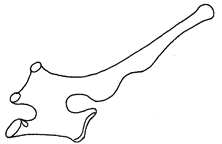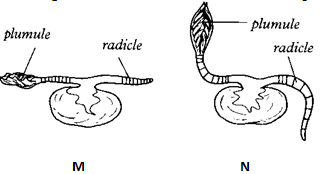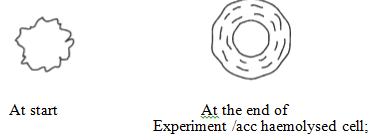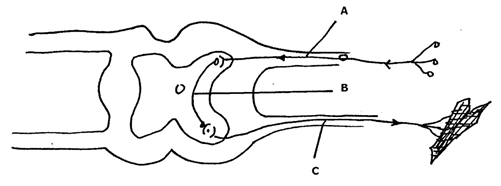- Some form one students wanted to collect the following animals for study in the laboratory. State the suitable apparatus they should use.
- Flying insects (1 mark)
- Sweep net;
- Crawling stinging insects (1 mark)
- pair of forceps;
- Small animals from tree barks (1 mark)
- pooter
- Flying insects (1 mark)
- The diagram below represents a mammalian vertebra.
- Identify the vertebra represented above. (1mk)
- Thoracic vertebrae ;
- Give a reason for your answer. (1mk)
- Long neurospine; short transverse processes;
- Presence of tubercular/capitular demi - facets;
- Identify the vertebra represented above. (1mk)
-
- Explain the role of oxygen in Active transport (1mk
- Oxidize food to produce energy required in active transport rej to produce energy
- Name two processes that depend on Active transport in animals (2mks)
- Reabsorption of sugar and some salts by kidney;
- Absorption of digested food from alimentary canal;
- Excretion of waste products from body cell;
- Explain the role of oxygen in Active transport (1mk
- Explain how sunken stomata lower the rate of transpiration (2mks)
- Form pits that accumulate moisture; lowering saturation deficit between the atmosphere and sub stomatal airspaces; reducing transpiration.
- State how xylem vessel is adapted to its function (3mks)
- Lignified walls to prevent them from collapsing ;
- Hollow and tubular for continuous flow of water;
- Narrow to enhance capillarity;
- Made of dead cells; are impervious thus cannot lose water sideways.
-
- Define the term immunity. (1mk)
- Ability of the body to identify/ recognize foreign antigens and develop mechanisms of destroying them / ability to resist infection;
- Distinguish between natural immunity and acquired immunity. (1mk)
- Natural immunity is inborn /inherited /passed from parents to offspring while acquired immunity is obtained in life;
- Identify one immunizable disease in Kenya. (1mk
- Tuberculosis; poliomyelitis; diphtheria; whooping cough; measles;
- Define the term immunity. (1mk)
-
- State two adaptations of the alveolus to its functions. (2mks)
- Thin epithelium for easy diffusion of gases;
- Highly vascularized to transport gases/maintain a steep concentration gradient;
- Moist surface to dissolve gases;
- Why may an asthmatic patient produce a wheezing sound during breathing? (1mk)
- This is because muscles around the bronchioles contracts and so reduce their diameter.
- What is the significance of the cartilage found in the human trachea being incomplete (c- shaped rings) (1mk
- To permit swallowing in the oesophagus ;
- State two adaptations of the alveolus to its functions. (2mks)
- Define the following terms;
- Inter specific competition. (1mk)
- Competition between individuals of different species.
- Carrying capacity (1mk)
- Maximum number of organisms an area can comfortably support with depletion of available resources.
- Inter specific competition. (1mk)
- Suggest two methods that can be used to determine that type of food eaten by animals.(2mks)
- Analyzing animal droppings
- Direct observation of the animal while feeding
- Dissection and analysis of the gut content
- Dentition
-
- State one significance of genetics counseling (1mk)
- Provides information and advice to enable the victim to arrive at an informed decision.
- Part of a strand of DNA molecules was found to have the following sequence
A-T-C-G-G-G-A-T-C-T. What is the sequence?- Of the complementary strand? (1mk)
- T-A-G-C-C-C-T-A-G-A
- On a m- RNA strand copied
- U-A-G-C-C-C-U-G-U (1mk)
- Of the complementary strand? (1mk)
- State one significance of genetics counseling (1mk)
- The paddles of whales and the fins of fish adapt these organisms to aquatic habitats
- Name the evolutionary process that may have given rise to these structures. (1mk)
- Convergent evolution;
- What is the name given to such structures? (1mk)
- Analogous structures;
- Give two examples of vestigial organs in man. (2mk)
- Coccyx; appendix; reduced ear muscles/nictating membrane/reduced body hair;
- Name the evolutionary process that may have given rise to these structures. (1mk)
- An experiment was set to investigate a certain aspect of response. A seedling was put on a horizontal position as shown in figure M below. After 24 hours, the set up was as shown in figure N.
- Name the response exhibited. (1mk)
- Geotropism;
- Explain the curvature of the shoot upwards. (3mk)
- Gravity causes downward migration of auxins; causing high concentration of auxins on the lower part of the shoot; this stimulates faster growth on the lower part compared to the upper part; making the shoot to curve upwards
- Name the response exhibited. (1mk)
- The following is an equation representing a type of respiration
C6H12O6 → 2C2H5OH + 2CO2 + Energy- Identify the type of respiration. (1mk)
- Anaerobic respiration in plants; Rej anaerobic respiration alone
- Suggest one industrial application of the process shown in the equation above (1mk)
- Beer brewing
- Bread baking / leavening of bread
- Processing dairy products;
Acc. Correct examples) - Biogas production
- Sewage treatment
- Production of organic acids; (Mark any first one )
- Identify the type of respiration. (1mk)
-
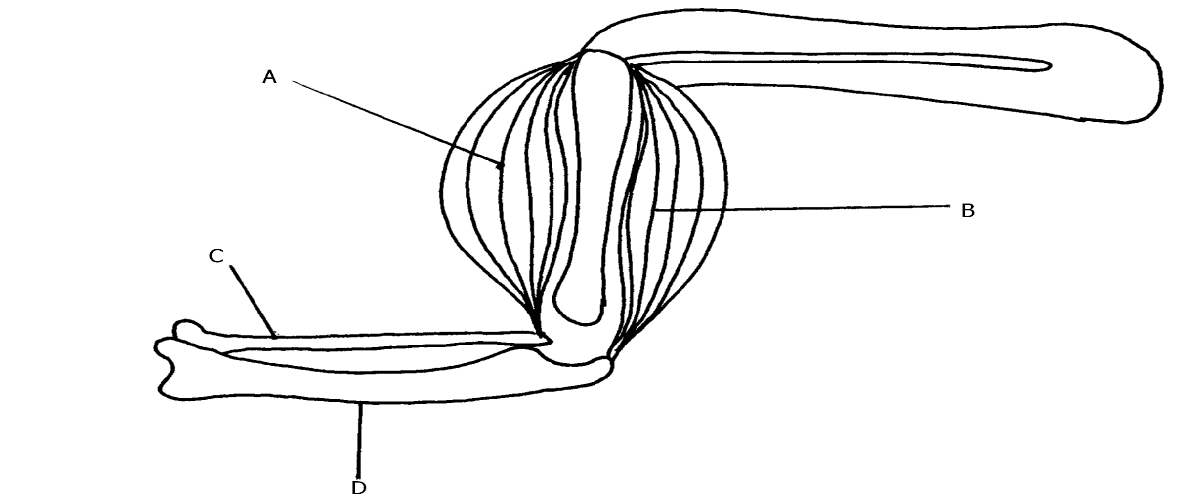
- Name the bones labeled C and D. (2 mark)
- C-Radius
- D-Ulna
- What happens to structure A and B as the arm is straightened. (1 mark)
- Muscle B contracts and muscle A relax
- Name the bones labeled C and D. (2 mark)
- Below is a graphical representation of the effects of different concentration of auxins on shoot and root growth. Study it carefully and then answer the questions that follow.
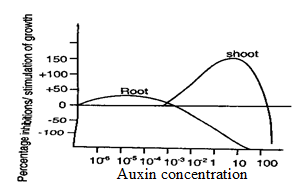
- Identify any two conclusions that can be drawn from the graph. (2mks)
- Auxins influence growth in both roots and shoots; shoots require more auxin to stimulate growth than roots/roots require less auxin to stimulate growth; higher auxin concentration in roots inhibit growth;
- Name the growth hormone responsible for ripening of fruits. (1mk)
- Ethylene/ethane;
- Identify any two conclusions that can be drawn from the graph. (2mks)
- The illustration below shows a transverse section through a mammalian kidney.
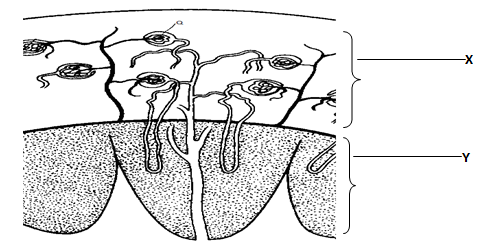
- Name the structures labelled X and Y.
- X Cortex; (1mk)
- Y Medulla; (1 mk)
- State the process in Q that leads to the formation of glomerular filtrate. (1mk)
- Ultrafiltration ;
- Name the structures labelled X and Y.
- State three differences in composition between umbilical artery and umbilical vein. (3 marks)
Umbilical vein
Umbilical artery
Rich in food nutrients e.g glucose
Less food nutrients
Has more Oxygen
Has less Oxygen
Has less nitrogenous wastes e.g urea
Has more nitrogenous wastes
less Carbon(IV) oxide
more Carbon (IV) oxide
-
- What is meant by the term taxonomy? (1mk)
- It is the science of classification;
- When are two organisms considered to belong to the same species. (2mks)
- When they can freely interbreed; to give rise to viable/fertile offspring;
- What is meant by the term taxonomy? (1mk)
- The diagram below shows part of alimentary canal of a mammal
- Name the parts labeled A and C (2mks)
A - Duodenum
C - Oesophagus /gullet - State the function of the part labeled B (1mk)
- Temporally storage of feaces / undigested /indigestible materials/Absorption of water;
- Name the parts labeled A and C (2mks)
- The graph below shows the relationship between body temperatures and external temperatures in a human being and a snake. Study it and answer questions that follow.
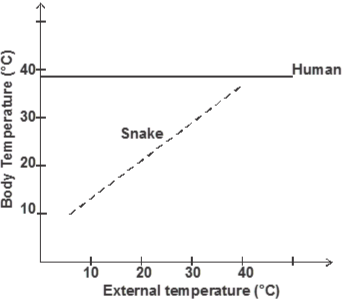
- What happens to the temperature of each organism as the external temperature increases.(2 marks)
- Human -remains constant;
- Snake -increases;
- Humans are described as homoithermic. State the advantage of this condition. (2marks)
- enables them to be active throughout;
- enables them exploit different habitats; (any one 1mk)
- What happens to the temperature of each organism as the external temperature increases.(2 marks)
-
- Name two products of light stage during photosynthesis. (2 marks)
- Hydrogen atom; oxygen gas;
- State three differences between light stage and dark stage of photosynthesis. (3 marks)
Light
Dark
Occur in presence of light
occur in grana
produce hydrogen atoms and oxygen gas
occur any time;
occur in stroma;
produce glucose;
- Name two products of light stage during photosynthesis. (2 marks)
- The diagram below represents a cell organelle.
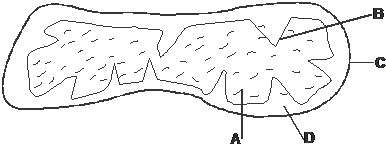
- Identify the organelle. (1 mark)
- Mitochondrion;
- Name the part labelled B (1 mark)
- Cristae;
- State the functions of the part labelled A (1 mark)
- Site for respiration
- Identify the organelle. (1 mark)
- The diagram below represents a plant cell that was subjected to a certain treatment.
- Account for the shape of the cell at the end of the experiment. (2 marks)
- Plant cell was placed in hypotonic solution to its cell sap, it gained water by osmosis.
- Draw a diagram to illustrate how an animal cell would appear if subjected to the same treatment. (1 marks)
- Account for the shape of the cell at the end of the experiment. (2 marks)
- Give a reason why each of the following steps are followed when preparing cross sections of a leaf for examination under a microscope.
- Cutting thin sections. (1 mark)
- To allow light to penetrate the sections;
- Also avoids overlapping of tissues;
- Placing the sections in water. (1 mark)
- To avoid drying up which may distort the cells;
- To maintain turgidity of the cells
- Cutting thin sections. (1 mark)
-
- Name two tissues in plants that provide mechanical support. (2 marks)
- Xylem tissues;
- Collenchyma tissues;
- Turgid parenchyma tissues;
- Schlerenchyma tissues;
- Name the types of joints formed by each of the following pairs of bones:
- Axis and atlas. (1 mark)
- Pivotal joint;
- Humerus with clavicle and scapula. (1mk)
- Ball and socket joint
- Axis and atlas. (1 mark)
- Name two tissues in plants that provide mechanical support. (2 marks)
- The diagram below represents a simple reflex arc
- Name the parts labeled A, B and C (3mks)
A -sensory Neurone
B—Relay Neurone
C—Motor Neurone - What is the role of part A (1mk)
- Conduct impulse from the sensory organ to the spinal cord /CNS;
- Name the parts labeled A, B and C (3mks)
Download BIOLOGY PAPER 1 Marking scheme - 2017 MURANG'A MOCK EXAMINATION.
Tap Here to Download for 50/-
Get on WhatsApp for 50/-
Why download?
- ✔ To read offline at any time.
- ✔ To Print at your convenience
- ✔ Share Easily with Friends / Students

